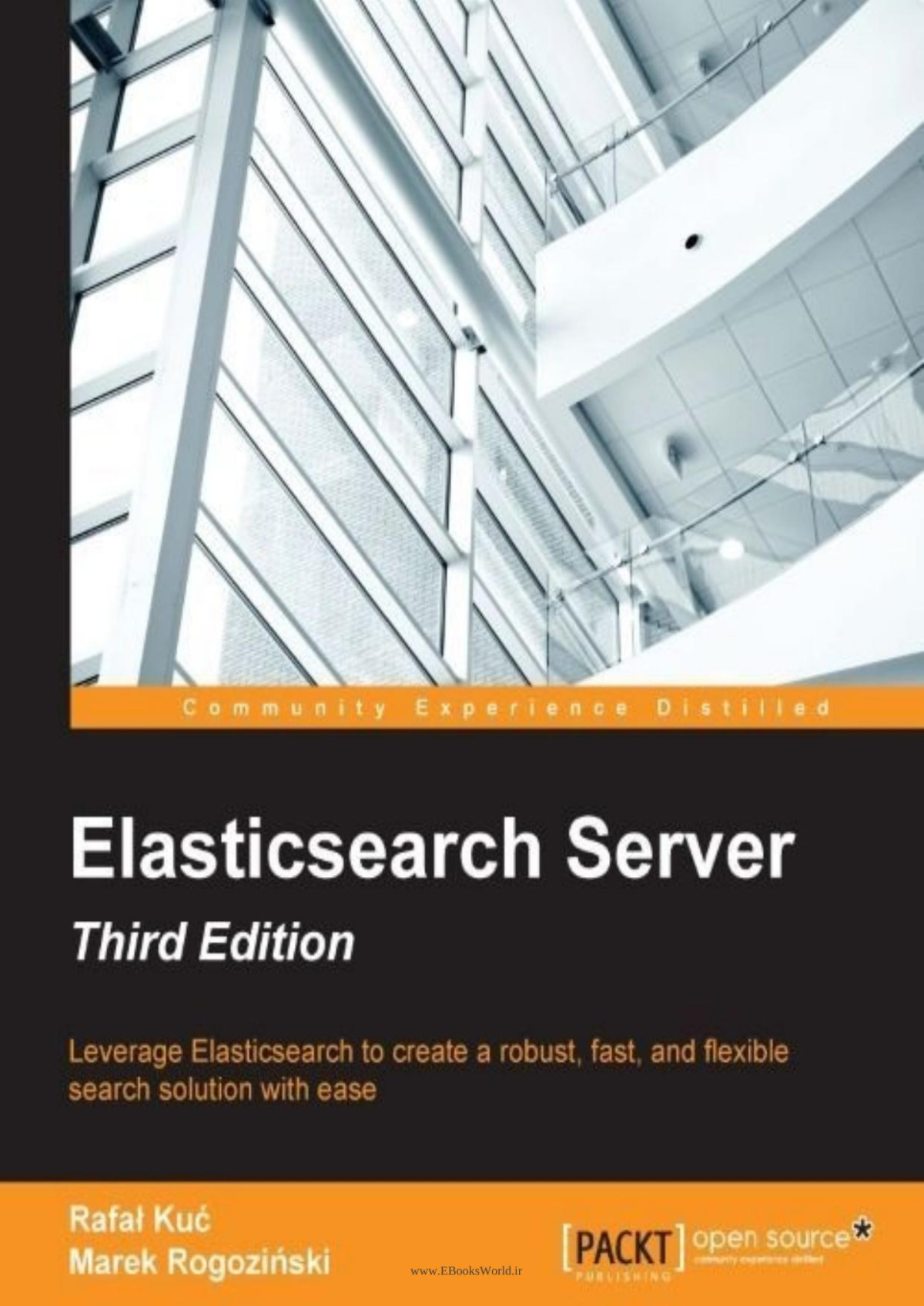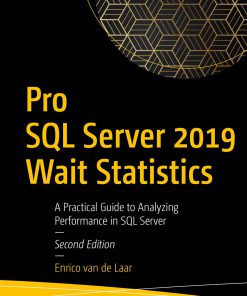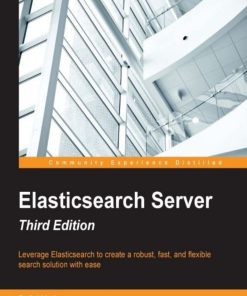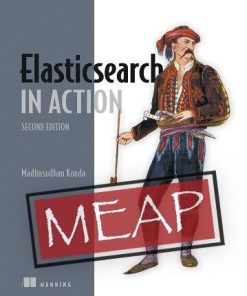Elasticsearch Server 3rd edition by Rafal Kuc Marek Rogozinski ISBN 1785888811 978-1785888816
$50.00 Original price was: $50.00.$25.00Current price is: $25.00.
Elasticsearch Server 3rd edition by Rafal Kuc Marek Rogozinski – Ebook PDF Instant Download/Delivery: 1785888811 978-1785888816
Full download Elasticsearch Server 3rd edition after payment

Product details:
ISBN 10: 1785888811
ISBN 13: 978-1785888816
Author: Rafal Kuc Marek Rogozinski
About This Book
- Boost the searching capabilities of your system through synonyms, multilingual data handling, nested objects and parent-child documents
- Deep dive into the world of data aggregation and data analysis with ElasticSearch
- Explore a wide range of ElasticSearch modules that define the behavior of a cluster
Who This Book Is For
If you are a competent developer and want to learn about the great and exciting world of ElasticSearch, then this book is for you. No prior knowledge of Java or Apache Lucene is needed.
What You Will Learn
- Configure, create, and retrieve data from your indices
- Use an ElasticSearch query DSL to create a wide range of queries
- Discover the highlighting and geographical search features offered by ElasticSearch
- Find out how to index data that is not flat or data that has a relationship
- Exploit a prospective search to search for queries not documents
- Use the aggregations framework to get more from your data and improve your client’s search experience
- Monitor your cluster state and health using the ElasticSearch API as well as third-party monitoring solutions
- Discover how to properly set up ElasticSearch for various use cases
In Detail
ElasticSearch is a very fast and scalable open source search engine, designed with distribution and cloud in mind, complete with all the goodies that Apache Lucene has to offer. ElasticSearch’s schema-free architecture allows developers to index and search unstructured content, making it perfectly suited for both small projects and large big data warehouses, even those with petabytes of unstructured data.
This book will guide you through the world of the most commonly used ElasticSearch server functionalities. You’ll start off by getting an understanding of the basics of ElasticSearch and its data indexing functionality. Next, you will see the querying capabilities of ElasticSearch, followed by a through explanation of scoring and search relevance. After this, you will explore the aggregation and data analysis capabilities of ElasticSearch and will learn how cluster administration and scaling can be used to boost your application performance. You’ll find out how to use the friendly REST APIs and how to tune ElasticSearch to make the most of it. By the end of this book, you will have be able to create amazing search solutions as per your project’s specifications.
Style and approach
This step-by-step guide is full of screenshots and real-world examples to take you on a journey through the wonderful world of full text search provided by ElasticSearch.
Elasticsearch Server 3rd Table of contents:
1. Getting Started with Elasticsearch Cluster
Full text searching
The Lucene glossary and architecture
Input data analysis
Indexing and querying
Scoring and query relevance
The basics of Elasticsearch
Key concepts of Elasticsearch
Index
Document
Document type
Mapping
Key concepts of the Elasticsearch infrastructure
Nodes and clusters
Shards
Replicas
Gateway
Indexing and searching
Installing and configuring your cluster
Installing Java
Installing Elasticsearch
Running Elasticsearch
Shutting down Elasticsearch
The directory layout
Configuring Elasticsearch
The system-specific installation and configuration
Installing Elasticsearch on Linux
Installing Elasticsearch using RPM packages
Installing Elasticsearch using the DEB package
Elasticsearch configuration file localization
Configuring Elasticsearch as a system service on Linux
Elasticsearch as a system service on Windows
Manipulating data with the REST API
Understanding the REST API
Storing data in Elasticsearch
Creating a new document
Automatic identifier creation
Retrieving documents
Updating documents
Dealing with non-existing documents
Adding partial documents
Deleting documents
Versioning
Usage example
Versioning from external systems
Searching with the URI request query
Sample data
URI search
Elasticsearch query response
Query analysis
URI query string parameters
The query
The default search field
Analyzer
The default operator property
Query explanation
The fields returned
Sorting the results
The search timeout
The results window
Limiting per-shard results
Ignoring unavailable indices
The search type
Lowercasing term expansion
Wildcard and prefix analysis
Lucene query syntax
Summary
2. Indexing Your Data
Elasticsearch indexing
Shards and replicas
Write consistency
Creating indices
Altering automatic index creation
Settings for a newly created index
Index deletion
Mappings configuration
Type determining mechanism
Disabling the type determining mechanism
Tuning the type determining mechanism for numeric types
Tuning the type determining mechanism for dates
Index structure mapping
Type and types definition
Fields
Core types
Common attributes
String
Number
Boolean
Binary
Date
Multi fields
The IP address type
Token count type
Using analyzers
Out-of-the-box analyzers
Defining your own analyzers
Default analyzers
Different similarity models
Setting per-field similarity
Available similarity models
Configuring default similarity
Configuring BM25 similarity
Configuring DFR similarity
Configuring IB similarity
Batch indexing to speed up your indexing process
Preparing data for bulk indexing
Indexing the data
The _all field
The _source field
Additional internal fields
Introduction to segment merging
Segment merging
The need for segment merging
The merge policy
The merge scheduler
Throttling
Introduction to routing
Default indexing
Default searching
Routing
The routing parameters
Routing fields
Summary
3. Searching Your Data
Querying Elasticsearch
The example data
A simple query
Paging and result size
Returning the version value
Limiting the score
Choosing the fields that we want to return
Source filtering
Using the script fields
Passing parameters to the script fields
Understanding the querying process
Query logic
Search type
Search execution preference
Search shards API
Basic queries
The term query
The terms query
The match all query
The type query
The exists query
The missing query
The common terms query
The match query
The Boolean match query
The phrase match query
The match phrase prefix query
The multi match query
The query string query
Running the query string query against multiple fields
The simple query string query
The identifiers query
The prefix query
The fuzzy query
The wildcard query
The range query
Regular expression query
The more like this query
Compound queries
The bool query
The dis_max query
The boosting query
The constant_score query
The indices query
Using span queries
A span
Span term query
Span first query
Span near query
Span or query
Span not query
Span within query
Span containing query
Span multi query
Performance considerations
Choosing the right query
The use cases
Limiting results to given tags
Searching for values in a range
Boosting some of the matched documents
Ignoring lower scoring partial queries
Using Lucene query syntax in queries
Handling user queries without errors
Autocomplete using prefixes
Finding terms similar to a given one
Matching phrases
Spans, spans everywhere
Summary
4. Extending Your Querying Knowledge
Filtering your results
The context is the key
Explicit filtering with bool query
Highlighting
Getting started with highlighting
Field configuration
Under the hood
Forcing highlighter type
Configuring HTML tags
Controlling highlighted fragments
Global and local settings
Require matching
Custom highlighting query
The Postings highlighter
Validating your queries
Using the Validate API
Sorting data
Default sorting
Selecting fields used for sorting
Sorting mode
Specifying behavior for missing fields
Dynamic criteria
Calculate scoring when sorting
Query rewrite
Prefix query as an example
Getting back to Apache Lucene
Query rewrite properties
Summary
5. Extending Your Index Structure
Indexing tree-like structures
Data structure
Analysis
Indexing data that is not flat
Data
Objects
Arrays
Mappings
Final mappings
Sending the mappings to Elasticsearch
To be or not to be dynamic
Disabling object indexing
Using nested objects
Scoring and nested queries
Using the parent-child relationship
Index structure and data indexing
Child mappings
Parent mappings
The parent document
Child documents
Querying
Querying data in the child documents
Querying data in the parent documents
Performance considerations
Modifying your index structure with the update API
The mappings
Adding a new field to the existing index
Modifying fields of an existing index
Summary
6. Make Your Search Better
Introduction to Apache Lucene scoring
When a document is matched
Default scoring formula
Relevancy matters
Scripting capabilities of Elasticsearch
Objects available during script execution
Script types
In file scripts
Inline scripts
Indexed scripts
Querying with scripts
Scripting with parameters
Script languages
Using other than embedded languages
Using native code
The factory implementation
Implementing the native script
The plugin definition
Installing the plugin
Running the script
Searching content in different languages
Handling languages differently
Handling multiple languages
Detecting the language of the document
Sample document
The mappings
Querying
Queries with an identified language
Queries with an unknown language
Combining queries
Influencing scores with query boosts
The boost
Adding the boost to queries
Modifying the score
Constant score query
Boosting query
The function score query
Structure of the function query
The weight factor function
Field value factor function
The script score function
The random score function
Decay functions
When does index-time boosting make sense?
Defining boosting in the mappings
Words with the same meaning
Synonym filter
Synonyms in the mappings
Synonyms stored on the file system
Defining synonym rules
Using Apache Solr synonyms
Explicit synonyms
Equivalent synonyms
Expanding synonyms
Using WordNet synonyms
Query or index-time synonym expansion
Understanding the explain information
Understanding field analysis
Explaining the query
Summary
7. Aggregations for Data Analysis
Aggregations
General query structure
Inside the aggregations engine
Aggregation types
Metrics aggregations
Minimum, maximum, average, and sum
Missing values
Using scripts
Field value statistics and extended statistics
Value count
Field cardinality
Percentiles
Percentile ranks
Top hits aggregation
Additional parameters
Geo bounds aggregation
Scripted metrics aggregation
Buckets aggregations
Filter aggregation
Filters aggregation
Terms aggregation
Counts are approximate
Minimum document count
Range aggregation
Keyed buckets
Date range aggregation
IPv4 range aggregation
Missing aggregation
Histogram aggregation
Date histogram aggregation
Time zones
Geo distance aggregations
Geohash grid aggregation
Global aggregation
Significant terms aggregation
Choosing significant terms
Multiple value analysis
Sampler aggregation
Children aggregation
Nested aggregation
Reverse nested aggregation
Nesting aggregations and ordering buckets
Buckets ordering
Pipeline aggregations
Available types
Referencing other aggregations
Gaps in the data
Pipeline aggregation types
Min, max, sum, and average bucket aggregations
Cumulative sum aggregation
Bucket selector aggregation
Bucket script aggregation
Serial differencing aggregation
Derivative aggregation
Moving avg aggregation
Predicting future buckets
The models
Summary
8. Beyond Full-text Searching
Percolator
The index
Percolator preparation
Getting deeper
Controlling the size of returned results
Percolator and score calculation
Combining percolators with other functionalities
Getting the number of matching queries
Indexed document percolation
Elasticsearch spatial capabilities
Mapping preparation for spatial searches
Example data
Additional geo_field properties
Sample queries
Distance-based sorting
Bounding box filtering
Limiting the distance
Arbitrary geo shapes
Point
Envelope
Polygon
Multipolygon
An example usage
Storing shapes in the index
Using suggesters
Available suggester types
Including suggestions
Suggester response
Term suggester
Term suggester configuration options
Additional term suggester options
Phrase suggester
Configuration
Completion suggester
Indexing data
Querying indexed completion suggester data
Custom weights
Context suggester
Context types
Using context
Using the geo location context
The Scroll API
Problem definition
Scrolling to the rescue
Summary
9. Elasticsearch Cluster in Detail
Understanding node discovery
Discovery types
Node roles
Master node
Data node
Client node
Configuring node roles
Setting the cluster’s name
Zen discovery
Master election configuration
Configuring unicast
Fault detection ping settings
Cluster state updates control
Dealing with master unavailability
Adjusting HTTP transport settings
Disabling HTTP
HTTP port
HTTP host
The gateway and recovery modules
The gateway
Recovery control
Additional gateway recovery options
Indices recovery API
Delayed allocation
Index recovery prioritization
Templates and dynamic templates
Templates
An example of a template
Dynamic templates
The matching pattern
Field definitions
Elasticsearch plugins
The basics
Installing plugins
Removing plugins
Elasticsearch caches
Fielddata cache
Fielddata size
Circuit breakers
Fielddata and doc values
Shard request cache
Enabling and configuring the shard request cache
Per request shard request cache disabling
Shard request cache usage monitoring
Node query cache
Indexing buffers
When caches should be avoided
The update settings API
The cluster settings API
The indices settings API
Summary
10. Administrating Your Cluster
Elasticsearch time machine
Creating a snapshot repository
Creating snapshots
Additional parameters
Restoring a snapshot
Cleaning up – deleting old snapshots
Monitoring your cluster’s state and health
Cluster health API
Controlling information details
Additional parameters
Indices stats API
Docs
Store
Indexing, get, and search
Additional information
Nodes info API
Returned information
Nodes stats API
Cluster state API
Cluster stats API
Pending tasks API
Indices recovery API
Indices shard stores API
Indices segments API
Controlling the shard and replica allocation
Explicitly controlling allocation
Specifying node parameters
Configuration
Index creation
Excluding nodes from allocation
Requiring node attributes
Using the IP address for shard allocation
Disk-based shard allocation
Configuring disk based shard allocation
Disabling disk based shard allocation
The number of shards and replicas per node
Allocation throttling
Cluster-wide allocation
Allocation awareness
Forcing allocation awareness
Filtering
What do include, exclude, and require mean
Manually moving shards and replicas
Moving shards
Canceling shard allocation
Forcing shard allocation
Multiple commands per HTTP request
Allowing operations on primary shards
Handling rolling restarts
Controlling cluster rebalancing
Understanding rebalance
Cluster being ready
The cluster rebalance settings
Controlling when rebalancing will be allowed
Controlling the number of shards being moved between nodes concurrently
Controlling which shards may be rebalanced
The Cat API
The basics
Using Cat API
Common arguments
The examples
Getting information about the master node
Getting information about the nodes
Retrieving recovery information for an index
Warming up
Defining a new warming query
Retrieving the defined warming queries
Deleting a warming query
Disabling the warming up functionality
Choosing queries for warming
Index aliasing and using it to simplify your everyday work
An alias
Creating an alias
Modifying aliases
Combining commands
Retrieving aliases
Removing aliases
Filtering aliases
Aliases and routing
Zero downtime reindexing and aliases
Summary
11. Scaling by Example
Hardware
Physical servers or a cloud
CPU
RAM memory
Mass storage
The network
How many servers
Cost cutting
Preparing a single Elasticsearch node
The general preparations
Avoiding swapping
File descriptors
Virtual memory
The memory
Field data cache and breaking the circuit
Use doc values
RAM buffer for indexing
Index refresh rate
Thread pools
Horizontal expansion
Automatically creating the replicas
Redundancy and high availability
Cost and performance flexibility
Continuous upgrades
Multiple Elasticsearch instances on a single physical machine
Preventing a shard and its replicas from being on the same node
Designated node roles for larger clusters
Query aggregator nodes
Data nodes
Master eligible nodes
Preparing the cluster for high indexing and querying throughput
Indexing related advice
Index refresh rate
Thread pools tuning
Automatic store throttling
Handling time-based data
Multiple data paths
Data distribution
Bulk indexing
RAM buffer for indexing
Advice for high query rate scenarios
Shard request cache
Think about the queries
Parallelize your queries
Field data cache and breaking the circuit
Keep size and shard size under control
Monitoring
Elasticsearch HQ
Marvel
SPM for Elasticsearch
People also search for Elasticsearch Server 3rd:
how to login to elasticsearch server
connect to remote elasticsearch server
public elasticsearch server
elasticsearch serverless
start elasticsearch server
Tags:
Rafal Kuc,Marek Rogozinski,Elasticsearch Server
You may also like…
Uncategorized
Computers - Databases
Computers - Databases
Uncategorized
Computers - Enterprise Computing Systems
Elasticsearch Server 3rd edition by Rafal Kuc Marek Rogozinski ISBN 1785888811 978-1785888816
Computers - Algorithms and Data Structures
Elasticsearch in Action, Second Edition (MEAP V13) Madhusudhan Konda
Computers - Databases
Elasticsearch in Action, Second Edition (MEAP V07) Madhusudhan Konda











